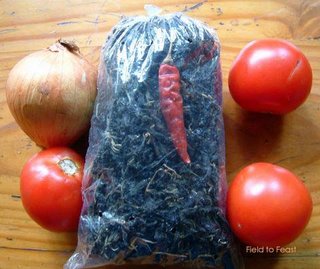 The worthy subject of this, my first proper entry, is sadza ne mufushwa wemunyemba. Sadza is Zimbabwe’s staple food, made from cooked “mealie-meal”. Mealie-meal is finely milled dried corn – and not just any corn. Zimbabweans grow African white corn in their tropical climate, and it has an earthy flavor quite distinct from the sweet corn to which Americans and Europeans are accustomed. So distinct, in fact, that on July 14 the BBC reported on a Zimbabwean living in London who, longing for the corn of his homeland, labored seven years to develop a type of African white corn that would grow in the very un-tropical U.K. He now has a lush field of corn beside the M25, and, I suppose, a plate of properly-made sadza on his plate every night.
The worthy subject of this, my first proper entry, is sadza ne mufushwa wemunyemba. Sadza is Zimbabwe’s staple food, made from cooked “mealie-meal”. Mealie-meal is finely milled dried corn – and not just any corn. Zimbabweans grow African white corn in their tropical climate, and it has an earthy flavor quite distinct from the sweet corn to which Americans and Europeans are accustomed. So distinct, in fact, that on July 14 the BBC reported on a Zimbabwean living in London who, longing for the corn of his homeland, labored seven years to develop a type of African white corn that would grow in the very un-tropical U.K. He now has a lush field of corn beside the M25, and, I suppose, a plate of properly-made sadza on his plate every night.
Sadza is similar to polenta, but more pliable, such that people can mould it into their hand and use it to pick up meat and/or relish. Ne means “with” in Shona, and, in the case of sadza ne mufushwa wemunyemba, sadza is served with a relish called mufushwa wemunyemba – the dried leaves of a particular bean plant. We ended up with some mufushwa by accident. My husband, Mark, frequents a market near our house, and the fruit and veg seller always throws something extra into his bag of purchases – a banana, say, or perhaps a pepper. Last week, however, the seller spotted Mark looking quizzically at the bag of mufushwa, and that was all it took to make it his free gift. We discovered more details about mufushwa from our housekeeper, Dorothy, who taught us this recipe:
We ended up with some mufushwa by accident. My husband, Mark, frequents a market near our house, and the fruit and veg seller always throws something extra into his bag of purchases – a banana, say, or perhaps a pepper. Last week, however, the seller spotted Mark looking quizzically at the bag of mufushwa, and that was all it took to make it his free gift. We discovered more details about mufushwa from our housekeeper, Dorothy, who taught us this recipe:
Dorothy’s Mufushwa
1 bag mufushwa (about 3 cups)
4 cups of water
2 tomatoes, chopped
1 onion, sliced thinly
3-4 tablespoons natural peanut butter
Salt, to taste
Bring the mufushwa and water to a boil, then turn down the heat and simmer for 2½ hours, or until the mufushwa is mushy and there is no water left in the pot. If the water is gone and the mufushwa still needs softening, add some more water and continue boiling.
Meanwhile, sauté the tomatoes and onion in the peanut butter until soft. (You may need to add a little oil, depending on the oiliness of your peanut butter.) Add this mixture to the cooked mufushwa, and season with salt. Serve hot with sadza.
The final product would be bitter if not for the peanut butter, which softens the flavor while making the texture smooth. It would be tasty served with rice, or perhaps tossed with some wide egg noodles. Zimbabweans tend to rely on salt for seasoning a dish, but I’d suggest intensifying the flavor of this recipe by sautéing a green chili in the peanut butter along with the tomato and onion.
Here is where most food blogs would show a mouth-watering picture of the artfully-arranged final dish. However, although sadza ne mufushwa wemunyemba is a dish I would eat again, it is a dish I would not hurry to look at again. Even Mark’s vaunted photographic skills could not find a way to flatteringly capture a lump of dark grey stuff sitting beside a lump of white stuff. My attempt at using the food blog lexicon also falls short. Would you feel inclined to eat “a silky grey mixture, spotted with tomato flecks and nestled beside some smooth, white polenta?” Probably not. Which goes to show I have much to learn from the food blog superstars about the type of recipes that belong in a blog entry on food, and those should that sit quietly in your recipe box, where only you can find them.






2 comments:
While I wouldn't hurry to cook the unphotogenic dish (eh..well..non-availability of main ingredient - African corn - being one of the reasons, I do appreciate your honesty (and sense of humor)!
Can't cook..but trying out your recipe...wish me luck ;-)
nK
Cape Town
Post a Comment